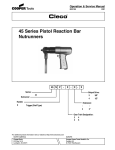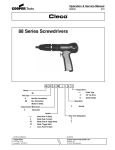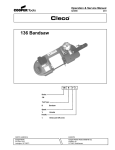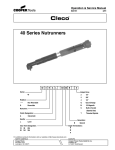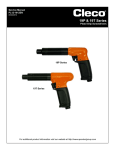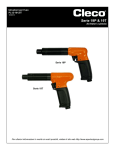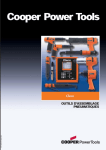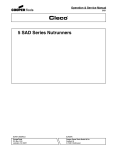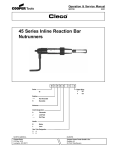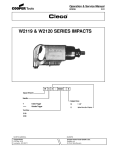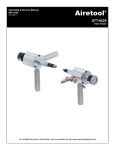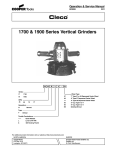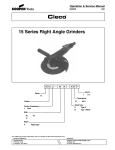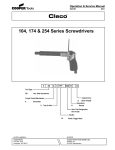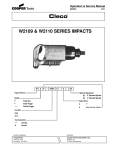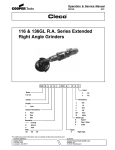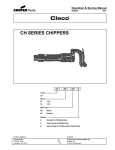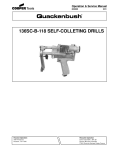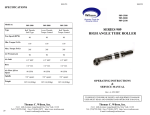Download warning - Apex Power Tools
Transcript
Operation & Service Manual 823091 2/01 35TNAL & 35TNL Series Tubenut Nutrunners 35 TN A L - XX - X Series: 35 Nutrunner: TN Terminations: Tubenut 6 9 Clutch Designation: A ----- Clecomatic Gear Train Designation: 5 10 7 Stall Handle: L Lever NORTH AMERICA EUROPE P.O. Box 1410 Lexington, SC 29071 Postfach 30 D-73461 Westhausen 1 Safety Recommendations For your safety and the safety of others, read and understand the safety recommendations and operating instructions before operating a nutrunner. may be repositioned with respect to the lever to accommodate proper location for task. If tool is to be reversed, locate throttle lever in a neutral position that will prevent entrapment. Refer to operating instructions for additional information. Always wear protective equipment: ! WARNING Impact resistant eye protection must be worn while operating or working near this tool. For additional information on eye protection and face protection, refer to Federal OSHA Regulations, 29 Code of Federal Regulations, Section 1910.133., Eye and Face Protection, and American National Standards Institute, ANSI Z87.1, Occupational and Educational Eye and Face Protection. Z87.1 is available from the American National Standards Institute, Inc., 11 West 42nd Street, New York, NY 10036. ! CAUTION It is essential for safe operation that any operator of a nutrunner use good balance, sure footing, and proper posture in anticipation of a torque reaction. Tools with clutches can stall rather than shut-off if adjusted over maximum power output of tool, or if there is a drop in air pressure. Operator must then resist stall torque until throttle is released. Spindle Rotation Tool balance arms are available to absorb the torque reaction of the tool while balancing the weight of the tool for improved ergonomic applications. ! Personal hearing protection is recommended when operating or working near this tool. Hearing protection is recommended in high noise areas 85 dBA or greater. The operation of other tools and equipment in the area, reflective surfaces, process noises and resonant structures can substantially contribute to, and increase the noise level in the area. Excessive air pressure above 90 PSIG or worn motor components can also increase sound level emitted by tool. Proper hearing conservation measures, including annual audiograms and training in the use and fit of hearing protection devices may be necessary. For additional information on hearing protection, refer to Federal Regulations, Section 1910.95, Occupational Noise Exposure, and American National Standards Institute, ANSI S12.6, Hearing Protectors. Cleco nutrunners are designed to operate on 90 psig (6.2 bar) maximum air pressure. If the tool is properly sized and applied, higher air pressure is unnecessary. Excessive air pressure increases the loads and stresses on the tool parts, sockets, and fasteners and may result in breakage. Installation of a filter-regulator-lubricator in the air supply line ahead of the tool is recommended. Before the tool is connected to the air supply, check the throttle for proper operation (i. e., throttle moves freely and returns to closed position). Being careful not to endanger adjacent personnel, clear the air hose of accumulated dust and moisture. Before connecting a tool to the air hose or removing a tool from service, make sure the air line is shut off and drained of air. This will prevent the tool from operating if the throttle is accidently engaged. ! CAUTION When using nutrunners, be sure the throttle is positioned relative to the head so that the throttle will not become wedged against an adjacent object in the "ON" position due to torque reaction. The head 2 Torque Reaction WARNING Pinch Hazard. To avoid injury to fingers, Keep hands away from wrench opening. 204208-3 Keep hands away from wrench opening to avoid injury to fingers. Some individuals may be susceptible to disorders of the hands and arms when performing tasks consisting of highly repetitive motions and/or exposure to extended vibration. Cumulative trauma disorders such as carpal tunnel syndrome and tendonitis may be caused or aggravated by repetitious, forceful exertions of the hands and arms. Vibration may contribute to a condition called Raynaud's Syndrome. These disorders develop gradually over periods of weeks, months, and years. It is presently unknown to what extent exposure to vibrations or repetitive motions may contribute to the disorders. Hereditary factors, vasculatory or circulatory problems, exposure to cold and dampness, diet, smoking and work practices are thought to contribute to the conditions. Any tool operator should be aware of the following warning signs and symptoms so that a problem can be addressed before it becomes a debilitating injury. Any user suffering proRepetitive work motions and/or vibration longed sympmay cause injury to hands and arms. toms of tingling, Use minimum hand grip force consistent with proper control and safe operation. numbness, Keep body and hands warm and dry. blanching of finAvoid anything that inhibits blood circulation. gers, clumsiness Avoid continuous vibration exposure. or weakened Keep wrists straight. grip, nocturnal Avoid repeated bending of wrists and hands. pain in the hand, or any other disorder of the shoulders, arms, wrists, or fingers is advised to consult a physician. If it is determined that the symptoms are job related or aggravated by movements and postures dictated by the job design, it may be necessary for the employer to take steps ! WARNING Safety Recommendations WARNING ! 203185-4 203185 OVER Repetitive work motions and/or vibration can cause injury to hands and arms. Use minimum hand grip force consistent with proper control and safe operation. Keep body and hands warm and dry. Avoid anything that inhibits blood circulation. Avoid continuous vibration exposure. Keep wrists straight. Avoid repeated bending of wrists and hands. Avoid OK CAUTION Avoid ! Avoid Personal hearing protection is recommended when operating or working near this tool. OK Hearing protection is recommended in high noise areas (above 85 dBA). Close proximity of other tools, reflective surfaces, process noises, and resonant structures can substantially contribute to the sound level experienced by the user. Avoid READ OPERATING INSTRUCTIONS WARNING • Avoid anything that inhibits blood circulation —Smoking Tobacco (another contributing factor) —Cold Temperatures —Certain Drugs Warning Labels The warning labels found on these tools are an essential part of this product. Labels should not be removed. Labels should be checked periodically for legibility. Replace warning labels when missing or when the information can no longer be read. Replacement labels can be ordered as any spare part. ! • Keep body and hands warm and dry (cold weather is reported to be a major factor contributing to Raynaud's Syndrome) Impact resistant eye protection must be worn while operating or working near this tool. • Use a minimum hand grip force consistent with proper control and safe operation This information is a compilation of general safety practices obtained from various sources available at the date of production. However, our company does not represent that every acceptable safety practice is offered herein, or that abnormal or unusual circumstances may not warrant or require additional procedures. Your work may require additional specific safety procedures. Follow these procedures as required by your company. Read Operating Instructions carefully. Follow the Safety Recommendations for your safety and the safety of others. The following suggestions will help reduce or moderate the effects of repetitive work motions and/or extended vibration exposure: For more information on the safe use of portable air tools, see the latest edition of ANSI B186.1, Safety Code for Portable Air Tools, available from the American National Standards Institute, Inc. 11 West 42nd Street, New York, NY 10036. Do not remove this tag until the operator of this tool has read these safety precautions. to prevent further occurrences. These steps might include, but are not limited to, repositioning the workpiece or redesigning the workstation, reassigning workers to other jobs, rotating jobs, changing work pace, and/or changing the type of tool used so as to minimize stress on the operator. Some tasks may require more than one type of tool to obtain the optimum operator/tool/task relationship. 203289 Extension Neutral Flexion Radial Deviation Neutral Ulnar Deviation ! • Tasks should be performed in such a manner that the wrists are maintained in a neutral position, which is not flexed, hyperextended, or turned side to side. 204208-3 • Stressful postures should be avoided — select a tool WARNING Pinch Hazard. To avoid injury to fingers, Keep hands away from wrench opening. 204208 • Avoid highly repetitive movements of hands and wrists, and continuous vibration exposure (after each period of operation, exercise to increase blood circulation) • Keep tool well maintained and replace worn parts Work gloves with vibration reducing liners and wrist supports are available from some manufacturers of industrial work gloves. Tool wraps and grips are also available from a number of different manufacturers. These gloves, wraps, and wrist supports are designed to reduce and moderate the effects of extended vibration exposure and repetitive wrist trauma. Since they vary widely in design, material, thickness, vibration reduction, and wrist support qualities, it is recommended that the glove, tool wrap, or wrist support manufacturer be consulted for items designed for your specific application. WARNING! Proper fit of gloves is important. Improperly fitted gloves may restrict blood flow to the fingers and can substantially reduce grip strength. 3 OPERATING INSTRUCTIONS CLECOMATIC MODELS Tools equipped with the CLECOMATIC clutch are designed to tighten the fastener to a predetermined torque and shut off automatically. Releasing the throttle lever will allow the tool to reset for the next cycle. CLECOMATIC CLUTCH ADJUSTMENT Shut off air supply to the tool and rotate the adjustment cover 202829, 180° to uncover the adjustment slot in the clutch housing. Rotate the spindle until the hole in the adjustment nut is visible in the slot. Use a 1/8" diameter pin to hold the nut. Use a suitable tool to turn the spindle in a counterclockwise direction to increase torque or clockwise to decrease torque. Return the adjustment cover to its closed position after every adjustment. If the clutch is adjusted over the maximum power output of the tool, the clutch will not function and the tool will operate like a stall-type tool. Also, if the tool is being operated at its upper torque limits, a drop in air pressure could cause the clutch not to function due to a loss of motor power and the tool will function like a stall-type tool. If tool stalls operator must resist stall torque until the throttle lever is released. Operational check: Grip tool securely and be prepared to counteract stall torque in case clutch is improperly adjusted. THIS IS A HIGH TORQUE TOOL. THROTTLE POSITION The throttle lever may be repositioned to accomodate proper location for task and to avoid hand entrapment. Repositioning of the head is done by adding or removing head positioning shims. Retighten head with proper wrench. AIR SUPPLY The tool is designed to operate at 90 psig (6.2 bar) air pressure. The air pressure should be checked at the tool's air inlet while the tool is running. For maximum performance, use a 5/16" I.D. air hose up to 8' in length. If additional length is required, a 3/8" I.D. or larger hose should be connected to the 5/16" I.D. hose. SERVICE INSTRUCTIONS LUBRICATION An automatic in-line filter-regulator-lubricator is recommended as it increases tool life and keeps the tool in sustained operation. The in-line lubricator should be regularly checked and filled with a good grade of 10W machine oil. Proper adjustment of the in-line lubricator is performed by placing a sheet of paper next to the exhaust ports and holding the throttle open approximately 30 seconds. The lubricator is properly set when a light stain of oil collects on the paper. Excessive amounts of oil should be avoided. Application of the tool should govern how frequently it is greased. It is recommended that the idler gears and head gears receive a generous amount of NLGI 2-EP grease at every repair cycle. STORAGE In the event that it becomes necessary to store the tool for an extended period of time (overnight, weekend, etc.), it should receive a generous amount of lubrication at that time and again when returned to service. The tool should be stored in a clean and dry environment. 4 DISASSEMBLY — GENERAL (ALL MODELS) Unscrew (left hand threads) and remove the head. Unscrew (left hand threads) and remove the clutch housing and clutch. Unscrew and remove the gear case assembly. Note: On models equipped with an automatic shut-off device, the trip rod should be removed at this time to prevent its being lost or misplaced. The motor unit may now be removed from the backhead. See the following paragraphs for complete disassembly instructions on the various subassemblies. NO. 6 TUBENUT HEAD DISASSEMBLY The pinion bearing retainer 863564, may be removed by utilizing a 5/8" hex nut. Engage the nut in the bearing retainer and unscrew the retainer using a deep socket. The base plate 204291 can be removed using a 3/32" hex wrench to unscrew four 204317 and two 204316 flat head screws. All gears and gear shafts slip fit in the base plate and housing, but it may be required to tap shafts out with a punch. All bearings must be pressed out of gears. The driven gear bearing 842517, can be pressed off pinion shaft 204298, and pinion shaft can be pressed through pinion shaft gear 204305, and driven gear 864819 .The pawl can be removed and pawl alignment pin 842481 can be driven out with punch. When reassembling head a generous amount of NLGI 2-EP grease should be applied to all gears. The pawl should be lightly greased. NO. 9 TUBENUT HEAD DISASSEMBLY The pinion bearing retainer 863564, may be removed by utilizing a 5/8" hex nut. Engage the nut in the bearing retainer and unscrew the retainer using a deep socket. The base plate 204650 can be removed using a 3/32" hex wrench to unscrew four 204317 and two 204316 flat head screws. All gears and gear shafts slip fit in the base plate and housing, but it may be required to tap shafts out with a punch. All bearings must be pressed out of gears. The driven gear bearing 842517, can be pressed off pinion shaft 204298, and pinion shaft can be pressed through pinion shaft gear 204305, and driven gear 864819 .The stop pin spring 204621 and stop pin 204639 can be removed. When reassembling head a generous amount of NLGI 2-EP grease should be applied to all gears. The pawl should be lightly greased. CLUTCH DISASSEMBLY Unscrew the adjustment nut 202824. This will allow the adjustment plate 202754, thrust bearing No. 847596, thrust race 202753, torque spring, release spring 202752, release sleeve 203271, three (3) steel balls 842161, ball retainer 203272, and five (5) steel balls 844077, to be removed from the clutch spindle assembly. Wash the spindle assembly in a solvent and rotate the cam 203270, to remove as much grease as possible. Remove the retainer ring 202749, ball plug 202748, and twelve (12) steel balls 842161, from the cam. This will allow the trip plunger 202745, reset spring 202763, and pin 843231, to be removed from the rear of the clutch spindle 202848. GEAR CASE DISASSEMBLY If replacement of the idler gear pins is necessary, they should be pressed out the rear of the spider. See Fig. 1 for replacement pin height. .240 .255 Front Rear Fig. 1 — Single Reduction Spider Double Reduction — Gear Train Both spiders should be removed from the rear of gear case 867907. Remove the retainer ring 844364, and press the bearing 847147, out the front of the gear case. If replacement of the idler gear pins is necessary, they should be pressed out the rear of the spider. See Fig. 2 for replacement pin height. .240 .360 .255 .375 Front Rear Front MOTOR REASSEMBLY Assemble the rear rotor bearing and rear bearing plate (press on the bearing's inner race) onto the rear rotor shaft until there is approximately .0015" clearance between the plate and rotor. .0015" (.038mm) Clearance Rear 10 2nd Reduction 5, 7, 10 1st Reduction Spider Spider Fig. 2 — Double Reduction Spiders MOTOR DISASSEMBLY Use a soft-faced hammer to drive the rotor out of the front rotor bearing 619377. This will allow the cylinder and five (5) rotor blades to be removed from the rotor. Set the rear bearing plate on the vise jaws with the rotor hanging down. Use a 7/32" punch to drive the rotor out of the rear rotor bearing. BACKHEAD DISASSEMBLY Unscrew and remove the inlet bushing 867882, for inspection and cleaning of the air inlet screen 833300. Replace the screen if clogged or torn. The throttle valve and related components may be removed by unscrewing the throttle valve cap 832207. The reversing valve 204172, and related components may be removed by unscrewing the second throttle valve cap 832207, and driving the pin 864734, in the side of the backhead out. REASSEMBLY — GENERAL All parts should be washed in a solvent and inspected for damage or wear. Particular attention should be given to all bearings, gears, gear pins, and rotor blades as failure of these parts could cause damage to more expensive parts. Rotor blades should be replaced every time tool is repaired or if they measure less than 3/16" on either end. Must be replaced if less than 3/16" (4.7mm) on either end. Assemble the five (5) rotor blades, cylinder, front bearing plate, and front rotor bearing (press on the bearing's inner race) to the rotor assembly. After final assembly, the cylinder should be held firmly, but not tightly between the two (2) bearing plates and the rotor should turn freely and not rub either bearing plate. BACKHEAD ASSEMBLY Assemble the backhead in reverse order of disassembly. Note: Throttle valve bushing is held in by #609 locktite only. TRIP ROD SIZING (CLECOMATIC MODELS) Assemble the tool completely less clutch assembly and trip rod. Position the right angle head in relation to the throttle lever. Use spacers 863698, to position head. Break assembly apart at the clutch housing and gear case (left hand threads) and install the spacers 869434, five (5) spacers 869423, and clutch assembly. Reassemble the tool. Measure gap between the clutch housing and gear case. Remove the appropriate number of spacers 869423, to allow clutch housing and gear case to make up tight. NOTE: Spacers are .030" (.76mm) thick. If there is not a gap, add spacers No. 869423, to achieve one. The total amount of spacers removed must be greater than the gap. EXAMPLE: Gap is .048" (1.22mm). Remove two (2) .030 (.76mm) thick spacers — .060 (1.52mm) total. Inspect and replace any "O"-rings or seals that show signs of wear or deterioration. All gears, gear pins, and open bearings should receive a generous amount of NLGI 2-EP grease during reassembly. During reassembly of the clutch, all parts should receive a thin coating of a mixture of 10W machine oil and NLGI 2-EP grease. Reassembly of all of the various sub-assemblies is in the reverse order of disassembly; however, the following paragraphs list some of the more important reassembly procedures. Install trip rod. Screw clutch housing down until tool begins to start, continue to screw the housing down after tool starts one revolution. Measure the gap between the clutch housing and gear case. Cut this amount off the trip rod. SAFETY CHECK After repair or replacement of parts, tools equipped with an automatic shut-off device should be tested to verify that the device is functioning properly. TUBENUT HEAD REASSEMBLY Assemble the tubenut head in the reverse order of disassembly. Note: Pinion gear needle bearing is a slip fit on pinion gear. Alignment of output gear is achieved by rotating the cam gear 204292 or 204641, until it stops against pawl 204296 or slot in cam gear 204641, then align opening in output gear with opening in housing. 5 NO. 6 - 35TNAL & TNL TUBENUT HEAD 843827 204291 869034 204304 812625 842481 ANGLE HEAD ADAPTER Stall Tools Only 204296 204302 204303 Drive Shaft Subassembly 201661 204293 204294 612229 OUTPUT GEAR PART NO. 204319 204320 204321 204297 204306 204308 204309 204310 204311 IN 5/16 MM 8 9 204301 10 11 12 7/16 204301 204295 1/2 13 864819 204784 204295 382253 3/8 204305 847734 382253 865192 204298 204791 Cam Gear Subassembly 201849 863698 865723 EXTENDED OUTPUT GEAR PART NO. 204373 204374 204375 204376 204377 204378 204379 204380 204381 IN 5/16 .008" .004" 847846 MM 842517 204300 8 9 863360 863564 3/8 7/16 10 11 12 204316 1/2 204207 13 204317 All extended sockets extend 3/8" from base plate of head. PARTS LIST PART NO. 204207 204291 204293 204294 204295 204296 204298Ð 204299 204300 204301 204302 204303 204304 204305Ð 204316 NAME OF PART Housing Base Plate Idler Gear (20T) Step Over Gear Idler Gear (16T) Pawl (includes 842481) Pinion Shaft Cam Gear Shaft Pinion Gear Idler Gear Shaft Idler Gear Shaft Step Over Gear Shaft Pawl Spring Pinion Shaft Gear Flat Head Screw (Short) *Number of spacers required is variable. †Denotes parts not included in subassemblies listed below. Driven gear subassembly may be purchased using part no. 201661 (Ð parts included 204298, 204305 & 864819). 6 QTY. 1 1 1 1 2 1 1 1 1 2 1 1 1 1 2 PART NO. 204317 204791 382253 612229 812625 842481 842517 843827 847734 847846 863360 863564 863698† 864819Ð 865723† 869034† NAME OF PART Flat Head Screw (Long) Cam Gear (20T) Cam Gear Bearing & Idler Gear Bearing Idler Gear Bearing Pawl Spring Retainer Pin Pawl Alignment Pin (included in 204296) Driven Gear Ball Bearing Driven Gear Needle Bearing Step Over Gear Bearing Pinion Ball Bearing Pinion Needle Bearing Pinion Bearing Retainer Head Positioning Shim (.008") Driven Gear Head Positioning Shim (.004") Head Adapter (Stall Tools Only) The complete No. 6 tubenut head and output gear (output gear size must be specified using chart above) can be purchased as a subassembly using Part No. 201663. QTY. 4 1 3 1 1 1 1 1 1 1 1 1 * 1 * 1 NO. 9 - 35TNAL & TNL TUBENUT HEAD 843827 204650 869034 ANGLE HEAD ADAPTER Stall Tools Only 204302 204303 Drive Shaft Subassembly 201661 204293 612229 204294 204305 847734 204639 204301 OUTPUT GEAR PART NO. 204654 204716 204717 204649 204640 IN 9/16 5/8 204621 204295 MM 13 14 15 382253 204301 204651 864819 204641 204298 865192 884125 863698 865723 204295 16 382253 EXTENDED OUTPUT GEAR PART NO. IN MM 204655 13 204718 14 204719 15 204656 9/16 204657 5/8 16 All extended sockets extend 3/8" from base plate of head. .008" .004" 847846 842517 204300 863360 863564 204316 204648 204317 PARTS LIST PART NO. 204293 204294 204295 204298Ð 204299 204300 204301 204302 204303 204305Ð 204316 204317 204621 204639 204641 204648 NAME OF PART Idler Gear (20T) Step Over Gear Idler Gear (16T) Pinion Shaft Cam Gear Shaft Pinion Gear Idler Gear Shaft Idler Gear Shaft Step Over Gear Shaft Pinion Shaft Gear Flat Head Screw (Short) Flat Head Screw (Long) Stop Pin Spring Stop Pin Cam Gear (24T) Housing *Number of spacers required is variable. †Denotes parts not included in subassemblies listed below. Driven gear subassembly may be purchased using part no. 201661 (Ð parts included 204298, 204305 & 864819). QTY. 1 1 2 1 1 1 2 1 1 1 2 4 1 1 1 1 PART NO. 204650 204651 382253 612229 842517 843827 847734 847846 863360 863564 863698† 864819Ð 865192 865723† 869034† 884125 NAME OF PART Base Plate Cam Gear Shaft Idler Gear Bearing Idler Gear Bearing Driven Gear Ball Bearing Driven Gear Needle Bearing Step Over Gear Bearing Pinion Ball Bearing Pinion Needle Bearing Pinion Bearing Retainer Head Positioning Shim (.008") Driven Gear Cam Gear Needle Bearing Head Positioning Shim (.004") Head Adapter (Stall Tools Only) Alignment Pin (included in housing) QTY. 1 1 2 1 1 1 1 1 1 1 * 1 1 * 1 4 The complete No. 9 tubenut head and output gear (output gear size must be specified using chart above) can be purchased as a subassembly using Part No. 201773. 7 35 CLECOMATIC CLUTCH 202749 202763 202748 202848 842161 843231 202745 842161 869423 .035/.030 869434 .097/.090 202824 847596 202754 202829 202745 202748 202749 202752 202753 202754 202762* 202763 202822 202824 202829 202848 203270 203271 203272 842161 843231 844077 847596 869305 869306 869423* 869434* 8 203271 202753 202762 PART NO. 203270 844077 202752 203272 869305 - 5 Red 869306 - 7 & - 10 Yellow NAME OF PART Trip Plunger Ball Plug Retainer Ring Release Spring Thrust Race Adjustment Plate Clutch Housing Reset Spring Torque Spring (Green) Adjustment Nut Adjustment Cover Clutch Spindle Clutch Cam Release Sleeve Ball Retainer 3/16" Steel Ball Reset Pin 5/16" Steel Ball Thrust Bearing Torque Spring (Red) Torque Spring (Yellow) Steel Spacer (.030"/.035") Spacer (.090"/.097") QTY. 1 1 1 1 1 1 1 1 1 1 1 1 1 1 1 15 1 5 1 1 1 ** 1 * Denotes parts not included in subassembly. ** Number of spacers required is variable. The complete clutch can be purchased as a subassembly using Part No. 201387 — 2, 5 201385 — 7, 10 201388 — 20 35- 5, 7 & 10 GEAR TRAINS - 5 & - 7 GEAR TRAINS 867922 203062 203143 832125 - 5 869254 - 7 869258 867921 847147 203144 - 5 869256 - 7 869851 884125 203062 844364 867903 867925 867902 867907 832128 867906 867904 869584 867905 - 10 GEAR TRAIN Part No. Name of Part 203062 203143 203144 832125 832128 844364 847147 867902 867903 867904 867905 867906 867907 867921 867922 867925 869254 869256 869258 869584* 869851 884125 2nd Red. Gear Bushing 5 & 7 2nd Red. Gear 5 & 7 2nd Red. Spider 5 & 7 2nd Red. Gear Pin 10 2nd Red. Gear Pin Retainer Ring Ball Bearing 10 Rotor Pinion (15T) 10 1st Red. Gear (15T) incl. 867925 10 2nd Red. Gear (15T) 10 1st Red. Spider - incl. 884125 10 2nd Red. Spider - incl. 832128 Gear Case 5 & 7 1st Red. Gear Bearing 5 & 7 1st Red. Gear Pin 10 1st Red. Gear Bushing 5 1st Red. Gear (19T) incl. 867921 5 1st Red. Spider incl. 867922 7 1st Red. Gear (17T) incl. 867921 Pinion Spacer 7 1st Red. Spider - incl. 867922 10 1st Red. Gear Pin Qty. 3 3 1 3 3 1 1 1 3 3 1 1 1 3 3 3 3 1 3 1 1 3 * Denotes parts not included in subassembly. The complete gear case can be purchased as a subassembly using Code Numbers listed below. 5 — Code No. 201325 7 — Code No. 201326 10 — Code No. 861578 9 MOTORS FOR 35TNAL & 35TNL 203126 203127 203128 203129 869583 5 & 10 Clecomatic (6T) 7 Clecomatic (9T) Stall 5 & 10 (6T) Stall 7 (9T) 812165 812165 202769 (Clecomatic Only) 847609 869788 619377 202719 202704 H203125 PARTS LIST PART NO. 10 NAME OF PART QTY. 202704 202719 202769 Front Bearing Plate Rear Bearing Plate Trip Rod (.062" Dia. x 5/4" Lg.) 1 1 1 H203125 203126 Cylinder (incl. 812165 (2) ) Rotor (Clecomatic 5 & 10) (6T) 1 1 203127 203128 203129 Rotor (Clecomatic 7) (9T) Rotor (Stall 5 & 10) (6T) Rotor (Stall 7) (9T) 1 1 1 619377 812165 Ball Bearing Cylinder Pin 1 2 847609 869583 869788 Ball Bearing Gear Case Spacer Rotor Blade 1 1 5 35TNAL NUTRUNNER HANDLE 203501 844307 204172 832207 847426 203361 844307 203501 204175 202701 203286 832207 412603 204170 832731 865728 869510 204173 204171 204174 867874 833300 863454 867882 864734 204176 202410 PARTS LIST — HANDLE FOR 35TNAL & 35TNL NUTRUNNER PART NO. 202410 202701* 203286* 203361 203501 204170 204171 204172 204173* 204174* 204175* 204176 NAME OF PART Lever Pin Motor Spacer Shut-Off Valve Spring Throttle Valve Throttle Valve Spring Backhead (incl. 204171 & 832731) Reversing Valve Bushing Reversing Valve Inlet Plate Shut-Off Valve Seal Lever QTY. PART NO. 1 412603 1 832207 1 832731 1 833300 2 844307 1 847426 1 863454 1 864734 1 865728 1 867874 1 867882 1 869510 NAME OF PART Bail Throttle Valve Cap (incl. 844307) Pin Inlet Screen Throttle Valve Cap "O"-ring Throttle Valve Seal Inlet Bushing "O"-ring Reversing Valve Retainer Pin Inlet Bushing Spring Exhaust Deflector Inlet Bushing Muffler QTY. 1 2 1 1 2 1 1 1 1 1 1 1 The complete handle can be purchased as a subassembly using the part number 201637. * Parts not included in 201637 handle subassembly. 11 670 Industrial Drive Lexington, SC 29072 Phone: (803) 359-1200 Fax: (803) 359-2013 12












